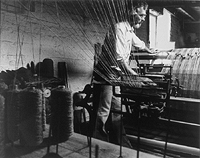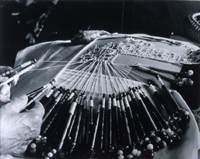Boats
Building
Cutlery
Fabric work
Furniture making
Glasswork
Leather work
Metal work
Stone work
Woodwork
Miscellaneous
Handloom weaver
Knitter
Lacemaker
Quilter
Hand loom weaving has moved from being an integral part
of the Yorkshire woollen industry to an activity which is pursued by
dedicated amateurs as a pastime. Keith and Margaret Brier were survivors
of the earlier domestic way of working. They worked from their home
in Upperthong which was a typical setting for the cottage industry of
the seventeenth and eighteenth centuries when whole families spun, wove
and still farmed.
 |
Margaret Brier of Upperthong near Holmfirth
at work on a tappit hand loom weaving a sample length of woollen
cloth. |
 |
Keith Brier preparing the warp on a warping
frame for his hand loom. |
Woollen garments for sailors and fishermen came to replace
sealskin clothing as seals became harder to obtain around the coast
of Britain. The style and terminology for these knitted garments seems
to have originated in the Channel Islands. "Ganseys" or "guernseys"
were customarily made from thick heavy dark blue wool, jerseys from
lighter, thinner yarns and a wider variety of colours.
 |
Mrs Ethel Richardson of Old Whitby, a
fisherman's wife, using the traditional four needles to knit a "gansey" |
Essentially a cottage industry to provide a little extra
money for families, lacemaking has always been at the mercy of either
fashion or competition from the Continent or from machines.
 |
Mrs Florence Longman of Wombleton near Helmsley making
a 'pillow' lace. |
Plain quilts consisting of sheets of whole cloth sandwiching
an inner layer of wadding, with the decoration being provided by the
stitching were popular in the Swaledale area of Yorkshire. It is thought
to be a much earlier craft than the patchwork style which only emerged
as more fanciful designs of woven textiles became more widely available.
 |
Miss Annie Pickard of Kirkbymoorside with her patchwork
quilt containing over three thousand hexagonal patches of different
print material, made on a wooden frame in her front parlour. |
